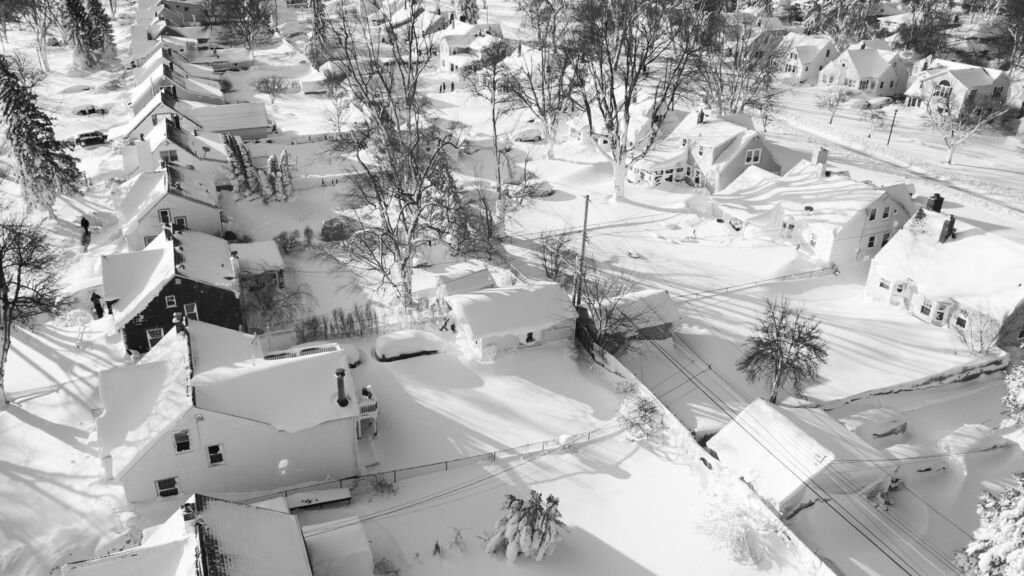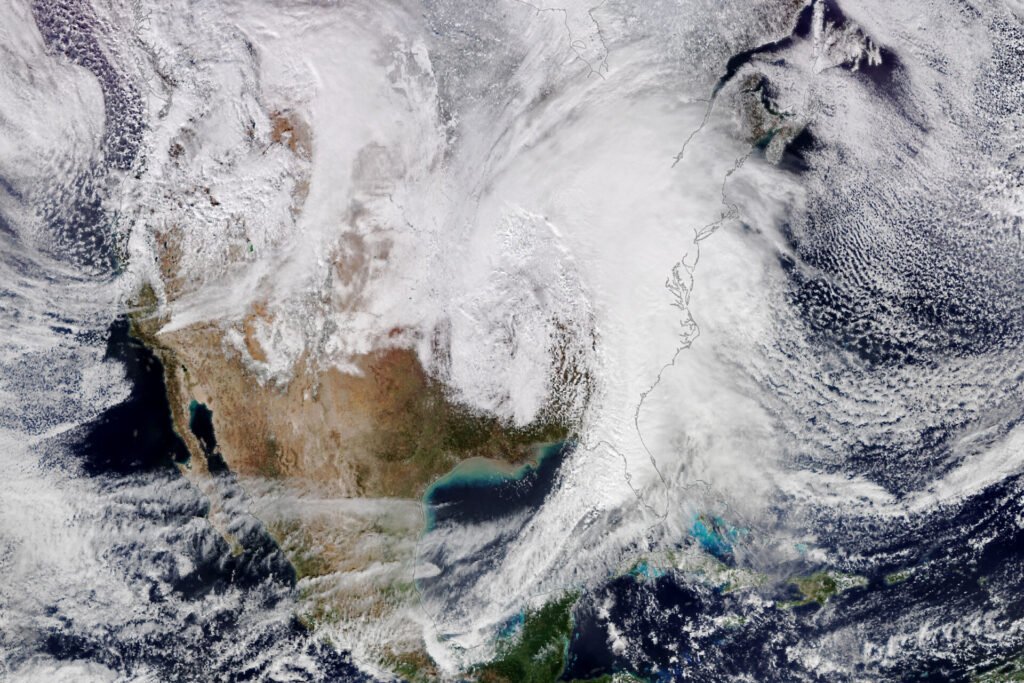Introduction:
The United States, with its sprawling landscapes and diverse climates, offers a dramatic stage for the brutal beauty of winter. The vast plains, mountains, and coastal regions of the USA create a complex stage for winter weather.

From the windswept Great Plains to the snow-laden peaks of the Rockies, the onslaught of blizzards, ice storms, and nor’easters transforms the nation.
These storms are not mere inconveniences; they are monumental forces of nature that reshape communities, cripple infrastructure, and test human resilience.
Types of Storms in the Winters of the USA:
The United States experiences a vast spectrum of winter storms. Here’s a breakdown of the most common and impactful types:

1. Blizzards:
Defining Features: Prolonged periods (at least 3 hours) of heavy snow, with winds exceeding 35 mph, leading to near-zero visibility (less than a quarter mile).
Impact: Crippling transportation, widespread power outages, potentially life-threatening conditions due to wind chill and disorientation.
Typical Regions: Northern Plains, Upper Midwest, Northeast.
2. Nor'easters:
Defining Features: Powerful low-pressure systems forming along the East Coast, pulling moisture from the Atlantic Ocean. They bring heavy snow, blizzard-like conditions, and strong winds and can cause coastal flooding.
Impact: Major disruptions to travel and infrastructure, storm surges, beach erosion.
Typical Regions: Northeast and Mid-Atlantic states.
3. Ice Storms:
Defining Features: Periods of freezing rain accumulating on surfaces like roadways, trees, and power lines. The weight of the ice can be incredibly destructive.
Impact: Extremely dangerous travel conditions, widespread power outages due to downed trees and powerlines, and property damage.
Typical Regions: More common in the South and transition zones between warmer and colder areas.
4. Lake-Effect Snowstorms:
Defining Features: Intense, localized snow bands form downwind of the Great Lakes when cold air flows over warmer lake water. It can produce astonishing snowfall amounts in short periods.
Impact: Heavy snowfall in specific areas creates travel disruptions and hazards.
Typical Regions: Great Lakes Region, particularly areas like Buffalo, NY.
5. Other Notable Storms:
- Snow Squalls: Short-lived but intense bursts of heavy snow and high winds, leading to sudden reductions in visibility and hazardous driving conditions.
- Arctic Outbreaks: Periods of extremely cold air plunging southward from the polar regions, leading to dangerous wind chills and potential flash freezes.
- Atmospheric Rivers: (Primarily West Coast) Narrow bands of concentrated moisture flowing from the Pacific Ocean can cause heavy rain, flooding, and landslides in the western US. While technically not snowstorms, they can produce heavy snowfall in higher elevations.
What are the Meteorological Forces Shaping the Storms in the Winters of the USA:
A variety of factors influence the development and characteristics of the storms in the winters of the USA.
1. Temperature Contrasts: Winter storms thrive on stark differences in temperature. The clash between cold, dry air masses descending from the Arctic and warm, moist air rising from the south or from bodies of water sets the stage for instability and lift.
2. Moisture: Storms need fuel, and that fuel is water vapor. Sources of moisture for winter storms include the Gulf of Mexico, the Atlantic Ocean, the Pacific Ocean, and even the relatively warmer waters of the Great Lakes (for lake-effect events).
3. Lift: Air needs to be forced upward to cool and condense into precipitation. This lift can be due to –
- Fronts: Boundaries between air masses (warm fronts or cold fronts) often force warm air upward, leading to condensation and precipitation.
- Jet Stream: This fast-moving river of air high in the atmosphere helps “steer” storms. Dips or troughs in the jet stream pattern can enhance lift and create areas of low pressure.
- Topographic Lift: When moist air is forced up mountain slopes, it cools and leads to precipitation (especially on windward sides).
Specific Mechanisms:
1. Blizzards: These form when a strong area of low pressure combines with very cold air and ample moisture. Intense snowfall is driven by high winds as the low-pressure system deepens.
2. Nor’easters: These storms occur due to low-pressure systems developing or intensifying off the Eastern Seaboard. When a “nor’easter” blows with winds from the northeast, it pulls vast amounts of moisture in from the Atlantic, further increasing precipitation.
3. Ice Storms: When a shallow layer of cold air resides near the ground, and warmer, moist air flows above it, precipitation falls as rain but freezes upon contact with surfaces below freezing, resulting in dangerous ice accumulation.
4. Lake-Effect Snow: Cold, dry air moving over the warmer waters of the Great Lakes picks up moisture. When this air mass hits land, the moisture is forced upward, producing localized but often intense snowfall downwind of the lake.
Factors like upper-level wind patterns, the specific trajectory of a low-pressure system, and local geography all play key roles in determining the type, intensity, and location of a winter storm.
Effects of the Storms in the Winters of the USA:
A. Effects on Nature:
1. Wildlife Disruption: Heavy snow and ice can hinder animals’ ability to find food and shelter, leading to starvation and increased mortality rates. Storms can also displace wildlife, forcing them into unfamiliar territories or even into conflict with humans.
Example: The severe winter storms in early 2023 throughout the western U.S. placed immense stress on bighorn sheep, deer, and other wildlife populations, with significant losses reported.
2. Tree Damage and Forest Health: Ice accumulation can weigh down branches and topple entire trees, particularly in forests not adapted to such events. High winds also uproot trees, disrupting forest ecosystems and increasing wildfire risk.
Example: An ice storm in the Southern U.S. in early 2023 caused massive damage to trees in areas like Texas and Arkansas, with long-lasting impacts on urban landscapes and forests.
3. Changes to Hydrology: Heavy snowpack followed by rapid melts due to warmer storms can cause flooding, erosion, and landslides, altering river systems and damaging surrounding ecosystems.
Example: The “bomb cyclone” of late 2022 and its associated atmospheric rivers brought record-breaking rain and snowfall to California, leading to disastrous flooding and mudslides.
B. Effects on Humans:
1. Disrupted Transportation: Blizzards, ice storms, and heavy snow shut down roads, airports, and public transportation, stranding travelers and hindering the movement of essential goods.
Example: The December 2022 blizzard paralyzed areas like Buffalo, NY, with massive road closures, travel bans, and supply chain disruptions.
2. Power Outages and Infrastructure Damage: Weight from ice and snow, along with high winds, can take down power lines and damage buildings. This leaves communities without heat and essential services during extremely cold weather.

Example: Winter storms regularly cause power outages across the US, and the 2023 Texas ice storm was a stark reminder of infrastructure vulnerability in cold weather events.
3. Economic Impacts: Businesses close, transportation of goods is delayed, and people miss work due to winter storms. This results in significant financial losses for individuals and entire regions.
Example: The estimated cost of the recent December 2022 blizzard event ran into billions of dollars due to business shutdowns, travel cancellations, and property damage.
4. Safety Hazards and Loss of Life: Winter storms create treacherous conditions for driving and outdoor activities. Extreme cold leads to hypothermia and frostbite. Sadly, fatalities occur each year due to storm-related vehicle accidents, exposure, and structural collapses.
Historic Perspective of the Storms in the Winters of the USA:
1. The Great Blizzard of 1888: A benchmark of devastation, this blizzard paralyzed the North-eastern US with record snowfall, high winds, and hundreds of deaths.
2. The Armistice Day Blizzard (1940): A surprise storm hitting the Upper Midwest with rapid temperature drops, blinding snow, and caught many off-guard.
3. The Superstorm of 1993: A vast system, stretching from Canada to Central America, causing blizzards, coastal flooding, and severe weather across much of the eastern US.
List of Notable Recent Storms in the Winters of the USA:
1. December 2022 “Bomb Cyclone” Blizzard: This massive system brought blizzard conditions, record-breaking snowfall, and dangerously low wind chills to much of the central and eastern United States. Areas around the Great Lakes, like Buffalo, NY, were particularly hard hit.

2. California Atmospheric Rivers (December 2022 – January 2023): A series of powerful atmospheric rivers inundated California with record-breaking rainfall and heavy mountain snow. This led to severe flooding, mudslides, and power outages throughout the state.
3. Early 2023 Texas Ice Storm: This storm brought freezing rain and significant ice accumulation across portions of Texas, Arkansas, and surrounding states. The result was widespread tree damage, power outages, and extremely hazardous travel conditions.
4. North-eastern Nor’easter (January 2022): A powerful nor’easter impacted the North-eastern United States with blizzard conditions, significant snowfall, coastal flooding, and high winds.
5. Late 2022 Western US Winter Storms: Heavy snowstorms and a dangerous blast of arctic air swept across the western United States before Christmas 2022. This caused significant travel disruptions, power outages, and dangerous conditions.
These are only a few examples of the storms in the winters of the USA. Smaller, localized winter storms, such as lake-effect snow events and nor’easters impacting smaller sections of the coast, occur regularly during the winter season.
How to Detect the Storms in the Winters of the USA:
1. Weather Radar Network: Doppler radars across the US emit energy pulses to detect precipitation and its movement. They’re critical for pinpointing the location, intensity, type of winter precipitation (snow, sleet, freezing rain), and track of storms.
2. Satellite Imagery: Satellites provide a broad perspective of cloud patterns, storm development, and moisture movement. They are essential for detecting storms forming over oceans and remote regions.
3. Surface Weather Stations: A network of weather stations measures temperature, wind, pressure, and humidity. These data points feed into models and provide ground-truth verification for other detection methods.
4. Citizen Science: Reports from trained weather spotters and the public provide valuable real-time information regarding local conditions, helping refine forecasts.
How to Predict the Storms in the Winters of the USA:
1. Weather Models: Meteorologists utilize sophisticated computer models that simulate the atmosphere. These models ingest vast amounts of real-time data to calculate the likely development and trajectory of storms. Different models specialize in short-term, long-term, and regional forecasts.
2. Ensemble Forecasting: Running multiple weather models with slightly different starting conditions helps forecasters assess the range of possible outcomes, allowing them to determine the degree of confidence in their predictions.
3. Human Expertise: Experienced meteorologists analyze model output, real-time observations, and historical weather patterns. Their critical thinking adds nuance and interpretation to computer modeling, improving forecast accuracy.
Minimizing the Severity of the Storms in the Winters of the USA:
Prevention is an ongoing process. Every significant storm provides lessons about vulnerabilities and opportunities to improve our responses. While stopping storms is impossible, prevention focuses on minimizing impacts:
1. Infrastructure Preparation: Winterizing roads (plowing, salting), weatherizing power grids, improving building insulation, and protecting vulnerable infrastructure.
2. Public Warnings and Preparedness: Timely weather forecasts and warnings via media, emergency alerts, and local authorities allow individuals and businesses to take necessary precautions.
3. Evacuations (Rare): In extreme scenarios, evacuations may be necessary in areas prone to extreme flooding or storm surge associated with winter storms.
4. Community Resources: Ensuring shelters are available, providing resources to vulnerable populations, and pre-arranging for snow and ice removal.
5. Long-Term Planning: Smart land-use policies, building codes designed for local weather extremes, and climate change adaptation efforts increase resilience to future storms.
6. Advancement in Technology: Technology is constantly improving, with better radar capabilities, weather models, and communication systems.
Conclusion:
The winters of the United States bring a spectacle of nature’s raw power. The legacy of past winter storms underscores the dynamic relationship between humankind and the natural world.
From the earliest weather observations to today’s sophisticated models and detection systems, our ability to anticipate winter storms has grown exponentially.
We cannot control the weather, but we can choose to act: to update our infrastructure, to prioritize emergency preparedness, and to support continued research into the forces that shape our winters.
Let our understanding of these colossal storms drive us toward a safer, more prepared future.

